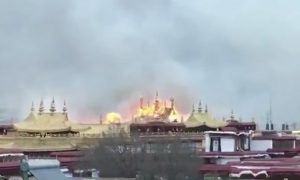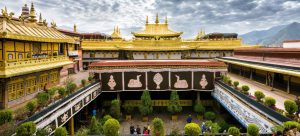
Photo: Twitter
A fire broke out at the ancient Jokhang temple in Lhasa on February 17, damaging the gilded roof and parts of the second and third floor of the UNESCO world heritage site, considered the heart of Tibetan Buddhism. Even two weeks later, the full extent of damage to the 1300 year-old monastery is still unknown, due to the censorship of all media reports pertaining to the event by the Chinese government.
While the incident caused an outpouring of grief and anguish from Tibetans across the world, it has also provoked the international media into questioning the Chinese authorities’ attempts to downplay the blaze and suppress all videos and photographs that showed several parts of the temple completely engulfed in flames for several hours.
Unwilling to even acknowledge the fire for up to five hours after it began, Communist party-controlled Chinese news agency only said that the fire was “put out swiftly” and that the revered Jowo Shakyamuni Buddha statue had not suffered any damage. Later it reported that the blaze had affected an area of 500 square feet. The Chinese government has also denied arson, claiming the fire, which broke out on the second day of Losar celebrations, was an accident. The Chinese authorities forbade locals from sharing videos of the blaze and threatened punishment to those who discussed the fire on social media, or attempted to give out eyewitness accounts to foreign media over the telephone.

Photo:tibetpedia.com
One of the country’s most politically sensitive sites and the location of the iconic anti-Beijing protests in the 1980’s, the Jhokang temple is home to numerous priceless cultural artefacts, including over 3,000 images of Buddhas, idols of other deities, relics, murals and manuscripts, numbering over 6,500 in total. Tibetan Buddhists and historians alike are anxious about the condition of these artefacts and alarmed by the lack of information or evidence that they are safe.
Residents of Lhasa who visited the temple for prayers as soon as it was opened told international press that many parts of the monument were cordoned off by large yellow curtains and that they could see charred debris behind them. The main chapel that houses the Jowo statue, believed to have been blessed by Buddha himself, has not been opened to public yet. The spectacular golden roof of the temple, that was seen burning from miles around Lhasa, has been removed – apparently to safeguard against collapse.
Speaking to the Los Angeles Times, Amy Heller, a Tibet expert and art historian at the East Asian Civilizations Research Centre in Paris, expressed her scepticism over the “official” version from the Chinese media. She noted that the official reported size of the fire is bigger than any of the individual chapels. “As for the matters of smoke damage, water damage, damage due to chemical products in fire extinguishers — we still know nothing,” she said.




 Print
Print Email
Email